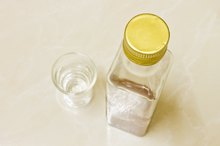How to Use Dry Ice to Remove Skin Cancers & Warts
Freezing cold therapy (called cryotherapy) has long been used as a way to remove skin cancers and warts. The process is relatively painless and can be done in an outpatient setting, which lets the patient leave right after the procedure. Using dry ice to remove skin cancers and warts from your skin at home can be an effective method, but is not something to be done casually. It will require patience and a steady hand in order to be done correctly.
Put some newspaper down on a work surface. Put on the work gloves.
How to Freeze Skin Moles at Home
Learn More
Wrap a piece of dry ice in some newspaper and put it down on the work surface. Beat the dry ice with a hammer until the pieces inside of the newspaper are very small.
Expose the section of skin that has the skin cancer or wart on it. Open the newspaper and take out a very small piece of dry ice, using your work glove.
Early Signs of Squamous Cell Mouth Cancer
Learn More
Place appendage with the skin cancer or wart down on the work surface. If it is in a difficult to reach area, you may need to lie on the surface and have a helper apply the dry ice.
Look at the wristwatch’s second hand as you carefully apply the tip of the dry ice to the skin cancer or wart 1. Do so for no more than 30 seconds. If your watch doesn't have a second hand, any timer that counts one-second increments will work.
Flex the body part that you applied the dry ice to until the cancer or wart drops off 1.
Dispose of the dry ice and throw the newspaper away. Dry ice can be washed down the sink or left to melt, but do not leave it unattended where others might touch it.
Repeat the process of applying the dry ice to the skin cancer or wart a week later if some of it is still visible on the skin 1.
Tips
Wart removal dry ice can be bought from a local ice store and is less painful to use than regular dry ice. It is not as strong as regular dry ice and might require additional applications in order to accomplish the task of removing the skin cancer or wart.
Warnings
See a doctor if you think there is a chance that the skin defect you have been treating could be malignant.
Related Articles
References
- Wart Removal Dry Ice
- InformedHealth.org. Warts: Overview. Cologne, Germany: Institute for Quality and Efficiency in Health Care (IQWiG). Updated November 7, 2019.
- InformedHealth.org. What are the treatment options for warts? Cologne, Germany: Institute for Quality and Efficiency in Health Care (IQWiG). Updated November 7, 2019.
- Al Aboud AM, Nigam PK. Wart (Plantar, Verruca Vulgaris, Verrucae). Treasure Island, FL: StatPearls Publishing. Updated September 27, 2019.
- Liu J, Li H, Yang F, et al. Epidemiology and Clinical Profile of Cutaneous Warts in Chinese College Students: A Cross-Sectional and Follow-Up Study. Sci Rep. 2018;8(1):15450. doi:10.1038/s41598-018-33511-x
- Goldman RD. Duct tape for warts in children: Should nature take its course?. Can Fam Physician. 2019;65(5):337-338.
- Cockayne S, Hewitt C, Hicks K, et al. Cryotherapy versus salicylic acid for the treatment of plantar warts (verrucae): a randomised controlled trial. BMJ. 2011;342:d3271. doi:10.1136/bmj.d3271
- Baker DA, Ferris DG, Martens MG, et al. Imiquimod 3.75% cream applied daily to treat anogenital warts: combined results from women in two randomized, placebo-controlled studies. Infect Dis Obstet Gynecol. 2011;2011:806105. doi:10.1155/2011/806105
- Gaston A, Garry RF. Topical vitamin A treatment of recalcitrant common warts. Virol J. 2012;9:21. doi:10.1186/1743-422X-9-21
- Walczuk I, Eertmans F, Rossel B, et al. Efficacy and safety of three cryotherapy devices for wart treatment: A randomized, controlled, investigator-blinded, comparative study. Dermatol Ther (Heidelb). 2018;8(2):203-16. doi:10.1007/s13555-017-0210-5
- Dalimunthe DA, Siregar R, Tanjung C. Comparative clinical efficacy between electrodesiccation with curettage and application of 80% phenol solution in treatment of common warts. Open Access Maced J Med Sci. 2018;6(2):326-9. doi:10.3889/oamjms.2018.074
- Chauhan PS, Mahajan VK, Mehta KS, Rawat R, Sharma V. The efficacy and safety of intralesional immunotherapy with measles, mumps, rubella virus vaccine for the treatment of common warts in adults. Indian Dermatol Online J. 2019;10(1):19-26. doi:10.4103/idoj.IDOJ_142_18
- Nofal A, Elkot R, Nofal E, Mazen M. Combination therapy versus monotherapy in the treatment of recalcitrant warts: A clinical and immunological study. J Cosmet Dermatol. 2018;2018;12848. doi:10.1111/jocd.12848
- Raghukumar S, Ravikumar BC, Vinay KN, et al. Intralesional vitamin D injection in the treatment of recalcitrant warts: A novel proposition. J Cutan Med Surg. 2017;21(4):320-4. doi:10.1177/1203475417704180
Tips
- Wart removal dry ice can be bought from a local ice store and is less painful to use than regular dry ice. It is not as strong as regular dry ice and might require additional applications in order to accomplish the task of removing the skin cancer or wart.
Warnings
- See a doctor if you think there is a chance that the skin defect you have been treating could be malignant.
Writer Bio
Marshal M. Rosenthal is a technology maven with more than 15 years of editorial experience. A graduate of Brooks Institute of Photography with a Bachelor of Arts in photographic arts, his editorial work has appeared both domestically as well as internationally in publications such as "Home Theater," "Electronic House," "eGear," "Computer and Video Games" and "Digitrends."








